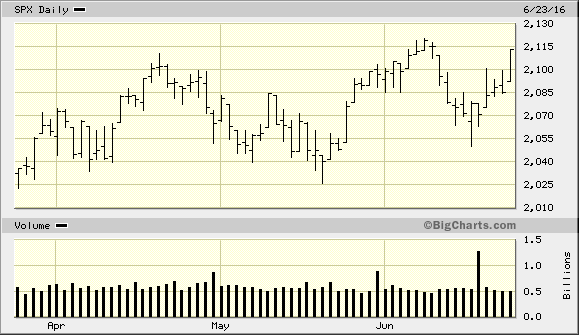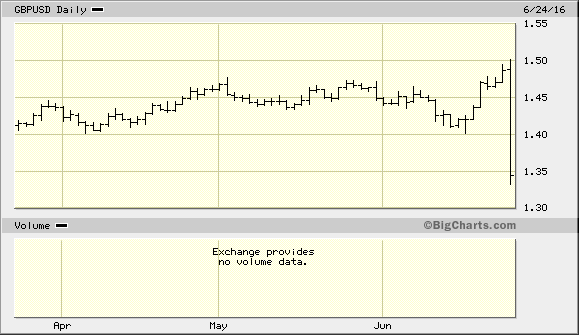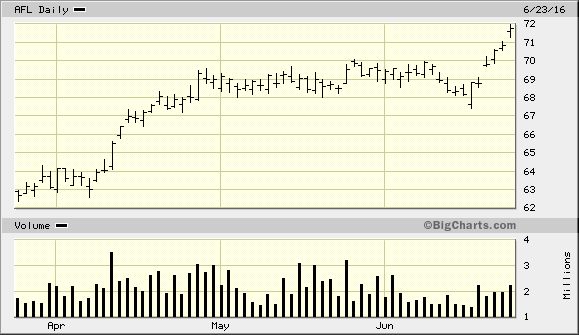CWS Market Review – June 24, 2016
“The second Vice is Lying; the first is running in Debt.” – Ben Franklin
I’m writing this to you early on Friday, and the big U.K. Brexit vote is still up in the air. Going into the vote, traders had been expecting a victory for Remain, which helped pushed the S&P 500 to within 1% of its all-time high. The index has now gone 54 days in a row without a 1% drop.
The buoyant market is also helping to lift some of our favorite Buy List stocks. Just this week, both Stryker and CR Bard made new 52-week highs. They’re turning into big winners for us this year. Thanks to the strong Japanese yen, shares of AFLAC just broke out to a new all-time high. The duck stock is a now a 20% winner on the year for us. I don’t think many people on Wall Street were expecting that.
In this week’s CWS Market Review, I’ll discuss this week’s earnings report from Bed Bath & Beyond. It wasn’t as good as I had hoped. I’ll have all the details in a bit. Also, Janet Yellen also went to Capitol Hill to give her semi-annual monetary policy testimony. I’ll focus on what she said, and what it means for us. But first, let’s look at the Brexit vote and how it’s impacting world markets.
The UK Votes
I tried to get the most current news on the Brexit Referendum for this issue, but I had to call for a deadline at some point, so some of this may already be dated. The vote simply appears to be too close to call. The initial news suggested that Remain was going to pull it out, but the early results indicate that it’s all up in the air.
As usual, I’ll withhold my political opinion on such matters, but I will address the investment implications. Financial markets were clearly nervous leading up to the big vote. A Leave decision, it’s believed, will cause a recession, and some damage will spill over to U.S. markets. Honestly, that’s probably overhyped, but rhetoric around political campaigns tends toward stoking fears. Since a Remain win had been expected, a Leave victory will probably unravel the market’s recent moves.
Every time a poll came out showing Leave ahead, the British pound would drop against the dollar and other major currencies. Then, quite suddenly, over the last few days, the British pound started to rally strongly. The pound jumped from roughly $1.40 to $1.50 in just a few sessions. This was a sign that world markets expected Remain to pull it out. Every rumor or new poll sent the pound careening back and forth. The implied volatility involved in betting on the pound reached the highest levels since the financial crisis.
As I’m watching the latest results, the pound is bouncing up and down like a tech stock from the 1990s. With this vote, there’s a large asymmetry. That’s a fancy way of saying that a Remain victory would be taken in stride, while an Exit win would freak everybody out. That’s actually quite common with investing. The Great Rule of investing is that things crash quickly, and recover slowly. In fact, by the time people realize that something bad is happening, it’s probably too late. In this case, the Exit forces were in full view.
As I write this, the S&P futures are down about 1.3%, which basically erases the entire gain from Thursday. As I said, these results aren’t final. The BBC reports that the Electoral Commission will have their results on Friday, “around breakfast time,” which may be the most British thing ever.
I don’t think a Brexit victory would hurt the U.S. economy, but it could spur other countries to ditch the EU. George Soros, who famously broke the Bank of England in 1992, said the pound could fall 15% to 20%. I would also expect money to flee to the perceived safety of U.S. assets.
My advice is don’t panic. Either result should have minimal effect on our Buy List stocks. I’ll have more to say once the outcome is clearer.
Yellen Still Sees the Need for Rate Hikes
This week, Janet Yellen headed to Capitol Hill to give her semiannual testimony on monetary policy. This comes after last week’s Fed meeting, in which the central bank decided to forgo raising interesting rates.
I’ll briefly summarize her comments. Yellen said that the pace of improvement in the jobs market has slowed down. While she was careful to say that it may not be the start of a larger trend, there does seem to be evidence that wage growth is picking up. If so, that would be very good news.
Yellen also noted that the strong dollar has weighed down the economy in recent quarters. That’s certainly been evident in the financial markets. (You may remember how much I spoke of the Strong Dollar trade.) Recently, business investment has been quite weak. On the plus side, Yellen said that Q2 GDP will probably be better than Q1, and that consumer spending appears to be rising.
Overall, Yellen said she’s optimistic for the economy, and she believes that gradual rate hikes may be needed. Hmmm. I’m not so sure about that, and the market doesn’t buy it either. Inflation is still quite low. Yellen also mentioned that the Chinese economy isn’t as healthy as it could be. That’s undoubtedly true.
Just look at the futures market. Traders currently think there’s a 63% chance the Fed will hold rates steady through the next three meetings. I would also think the pressure to do nothing will grow as Election Day gets closer. The yield on the two-year Treasury is currently at 0.78%. Sure, that rate has tripled in the last three years, but it’s gone from next to nothing to barely above next to nothing. The markets are clearly not concerned with any rate hikes.
With yields so low, the focus remains on stocks. In a few weeks, Q2 earnings season will begin. For the first time in a while, operating earnings are rising. The upcoming earnings season is projected to break our six-quarter run of lowering earnings.
According to S&P, analysts on Wall Street expect the S&P 500 to earn $28.41 for Q2. That’s the index-adjusted number. The estimate is down from $31.02 at the start of the year. Wall Street now expects the S&P 500 to earn $114 this year, and $134 for next year. Based on trailing earnings, the stock market looks a bit pricey. However, analysts expect this profit recession to end. If the profit estimates for next years are anywhere close to accurate, then the stock market is still quite reasonable.
Sluggish Quarter for Bed Bath & Beyond
We had one Buy List earnings report this week. After the closing bell on Wednesday, Bed Bath & Beyond (BBBY) reported fiscal Q1 earnings of 80 cents per share. That’s down from 93 cents per share for last year’s Q1. Wall Street had been expecting 86 cents per share.
This is not a strong report. Net sales were almost exactly the same as last year, while comparable-store sales fell by 0.5%. Digging into comparable-store sales, those from digital channels grew by over 20%, while in-store sales were down in “the low single-digits.”
One bright spot is that the company continues to buy back tons of its own stock. In the past year, shares outstanding dropped by 10%. You can expect the share count to continue to shrink. The company still has over $2 billion left in its current authorization. Bed Bath is also standing by its full-year profit range of $4.50 to $5 per share. Previously, they had said they expected to be at the high end of that range. Now they say they’ll be “comfortably within” that range. I’m not sure if that counts as lower guidance.
The shares dropped 5% in Wednesday’s after-hours market. Fortunately, the bears ran away in time for Thursday’s trading, as shares of BBBY gained 1.5%. I think the earnings call assuaged some investor fears. For example, the company seems to be very optimistic about its recent acquisition, One Kings Lane. On the conference call, Bed Bath updated its assumptions for the rest of this fiscal year. They expect comparable store sales to grow by 0% to 1%.
I also think there’s the simple fact that the negative sentiment was so strong that just about any news would be seen as positive. Quite frankly, I’m disappointed with Bed Bath’s performance. Perhaps there needs to be more pressure from shareholders to shake up management. I could be wrong, but I believe this is the first time they’ve taken questions on an earnings call. If I don’t see better performance here, I doubt BBBY will return to next year’s Buy List.
Top Buy List Bargains and New Buy Below Prices
I wanted to highlight a few Buy List stocks which I think look particularly attractive at the moment. I really like Ford Motor (F) below $13.50. It pays a generous dividend, and I expect a good earnings report in a few weeks. I also like Cognizant Technology Solutions (CTSH) here. This stock can move fast. In the banking sector, I really like Signature Bank (SBNY) when it’s below $135 per share. The bank has delivered 26 record quarters in a row.
Since this has been a fairly quiet time for our Buy List, I wanted to adjust a few of our Buy Below prices this week. Biogen (BIIB) continues to be weak, but I’m expecting a decent earnings report. This week, I’m lowering my Buy Below on Biogen to $265.
I also want to pare back Wabtec’s (WAB) Buy Below from $87 to $83. This isn’t a negative for either stock. I simply want the Buy Below prices to reflect the market’s current activity.
With Stryker’s (SYK) new high, I’m going to lift its Buy Below from $114 to $122 per share. Stryker is up 27% for us this year. I’m also going to raise our Buy Below on Fiserv (FISV) to $110 per share.
I also wanted to touch on AFLAC (AFL). As the yen has gained ground, the duck stock has quacked higher. When the yen was getting smacked around in 2014-15, I cautioned investors not to read too much into it, and that AFLAC is a well-run company. Now that we’re getting rewarded by forex, I still hold the same view.
AFLAC based this year’s earnings estimate on the yen’s being at 120.99 to the dollar. It’s now down to 104, and there’s talk of it soon breaking 100. Based on that 120.99 figure, AFLAC gave a full-year earnings range of $6.17 to $6.41 per share.
Basically, for every one yen the Japanese currency strengthens against the dollar, meaning the ratio goes down, three cents per share are added to AFLAC’s full-year profits. I estimate the yen has averaged 112 this year. That translates to a 27-cent headwind.
The shares tested $70 for several weeks in May and June, and have finally burst through. The duck stock came close to touching $72 per share on Thursday. AFLAC remains an excellent company.
That’s all for now. The first half of the year comes to a close next week. I’ll have a summary of our performance in next week’s issue. On Tuesday, the government will again revise its estimates for Q1 GDP growth. The last report said the economy grew by just 0.8% during the first three months of the year. We’ll also get key reports on personal income and spending. The big jobs report won’t be until the following Friday, July 8. Be sure to keep checking the blog for daily updates. I’ll have more market analysis for you in the next issue of CWS Market Review!
– Eddy
Posted by Eddy Elfenbein on June 24th, 2016 at 7:08 am
The information in this blog post represents my own opinions and does not contain a recommendation for any particular security or investment. I or my affiliates may hold positions or other interests in securities mentioned in the Blog, please see my Disclaimer page for my full disclaimer.
- Tweets by @EddyElfenbein
-
-
Archives
- April 2024
- March 2024
- February 2024
- January 2024
- December 2023
- November 2023
- October 2023
- September 2023
- August 2023
- July 2023
- June 2023
- May 2023
- April 2023
- March 2023
- February 2023
- January 2023
- December 2022
- November 2022
- October 2022
- September 2022
- August 2022
- July 2022
- June 2022
- May 2022
- April 2022
- March 2022
- February 2022
- January 2022
- December 2021
- November 2021
- October 2021
- September 2021
- August 2021
- July 2021
- June 2021
- May 2021
- April 2021
- March 2021
- February 2021
- January 2021
- December 2020
- November 2020
- October 2020
- September 2020
- August 2020
- July 2020
- June 2020
- May 2020
- April 2020
- March 2020
- February 2020
- January 2020
- December 2019
- November 2019
- October 2019
- September 2019
- August 2019
- July 2019
- June 2019
- May 2019
- April 2019
- March 2019
- February 2019
- January 2019
- December 2018
- November 2018
- October 2018
- September 2018
- August 2018
- July 2018
- June 2018
- May 2018
- April 2018
- March 2018
- February 2018
- January 2018
- December 2017
- November 2017
- October 2017
- September 2017
- August 2017
- July 2017
- June 2017
- May 2017
- April 2017
- March 2017
- February 2017
- January 2017
- December 2016
- November 2016
- October 2016
- September 2016
- August 2016
- July 2016
- June 2016
- May 2016
- April 2016
- March 2016
- February 2016
- January 2016
- December 2015
- November 2015
- October 2015
- September 2015
- August 2015
- July 2015
- June 2015
- May 2015
- April 2015
- March 2015
- February 2015
- January 2015
- December 2014
- November 2014
- October 2014
- September 2014
- August 2014
- July 2014
- June 2014
- May 2014
- April 2014
- March 2014
- February 2014
- January 2014
- December 2013
- November 2013
- October 2013
- September 2013
- August 2013
- July 2013
- June 2013
- May 2013
- April 2013
- March 2013
- February 2013
- January 2013
- December 2012
- November 2012
- October 2012
- September 2012
- August 2012
- July 2012
- June 2012
- May 2012
- April 2012
- March 2012
- February 2012
- January 2012
- December 2011
- November 2011
- October 2011
- September 2011
- August 2011
- July 2011
- June 2011
- May 2011
- April 2011
- March 2011
- February 2011
- January 2011
- December 2010
- November 2010
- October 2010
- September 2010
- August 2010
- July 2010
- June 2010
- May 2010
- April 2010
- March 2010
- February 2010
- January 2010
- December 2009
- November 2009
- October 2009
- September 2009
- August 2009
- July 2009
- June 2009
- May 2009
- April 2009
- March 2009
- February 2009
- January 2009
- December 2008
- November 2008
- October 2008
- September 2008
- August 2008
- July 2008
- June 2008
- May 2008
- April 2008
- March 2008
- February 2008
- January 2008
- December 2007
- November 2007
- October 2007
- September 2007
- August 2007
- July 2007
- June 2007
- May 2007
- April 2007
- March 2007
- February 2007
- January 2007
- December 2006
- November 2006
- October 2006
- September 2006
- August 2006
- July 2006
- June 2006
- May 2006
- April 2006
- March 2006
- February 2006
- January 2006
- December 2005
- November 2005
- October 2005
- September 2005
- August 2005
- July 2005



 Eddy Elfenbein is a Washington, DC-based speaker, portfolio manager and editor of the blog Crossing Wall Street. His
Eddy Elfenbein is a Washington, DC-based speaker, portfolio manager and editor of the blog Crossing Wall Street. His